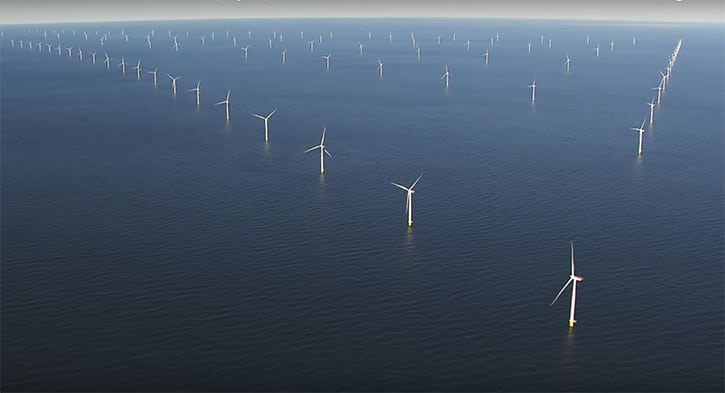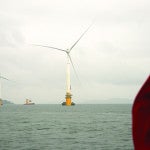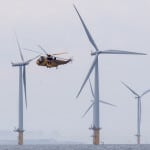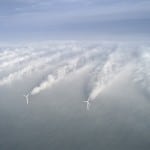Recent news out of Europe shows just how important wind energy has become to the continent. Record wind power consumption, huge capacity additions, and new expansion in previously untapped offshore areas are all making headlines, but policy changes and overproduction could start to become challenging.
Denmark Leads the Way
In Denmark, 2015 was a banner year for wind energy. The country’s wind turbines generated 42% of the Danes’ electricity consumption. And this occurred even while cable faults kept Denmark’s largest offshore wind farm—the 400-MW Anholt array (Figure 1)—offline for one month and the 209-MW Horn’s Rev 2 offshore wind farm out of operation for twice that long.
 |
1. The Anholt Offshore Wind Farm. The Anholt project was completed in 2013. It includes 111 turbines constructed between Djursland and the island of Anholt in the Kattegat. Courtesy: DONG Energy |
Wind power consumption has more than doubled in Denmark since 2009, when it produced 19.4% of the country’s needs. The majority of Danish wind turbines are located in the western part of its electricity system. That system experienced a surplus of wind energy, that is, periods when more wind power was produced than total electricity was consumed throughout the system, during 1,460 hours in 2015.
The overproduction only led to 65 hours of negative prices, however. Negative prices occur when generation is so high that producers have to pay to get rid of the electricity. For most of the surplus hours, power could be exported to neighboring countries that needed it.
“The increasingly fluctuating electricity generation means that we can benefit from imports and exports across borders to an even greater extent,” said Carsten Vittrup, energy strategy advisor for Energinet.dk, owner of the Danish electricity and gas transmission system.
“If, for some hours, we have surplus wind energy, the producers sell it to consumers in Norway, Sweden and Germany, and, conversely, we buy hydroelectric power from Norway, solar energy from Germany and power station electricity from Sweden, when it is advantageous for Denmark,” Vittrup said.
German Wind Energy Grows, but Faces Challenges
But demand for Denmark’s surplus power could be shrinking. That’s because Germany added more than 3.5 GW of its own wind power capacity in 2015. However, wind energy proponents are growing increasingly concerned about the future of wind power in Germany. That is because a planned amendment to Germany’s Renewable Energy Sources Act (EEG) does away with binding expansion targets and would manage land-based wind energy expansion by means of annually variable tendering.
“For the manufacturers, quantity control by means of tendering is in principle suitable for organising further competitive expansion. The EEG 2016 contains good suggestions for securing leadership in innovation, export success and industrial production in Germany. It is however not right to regulate the expansion of renewable energy production by controlling the tendering volume for onshore wind energy and inflexibly clinging on to a 45 per cent target in the electricity sector,” said Matthias Zelinger, managing director of VDMA Power Systems, a European trade association that represents the mechanical engineering industry.
Bundesverband WindEnergie e.V. (BWE)—Germany’s wind energy association—agrees with Zelinger. The two are demanding that the government coordinate the EEG 2016 with the Climate Protection Plan 2050. BWE and VDMA Power Systems also feel it is essential to even out the onshore wind energy tendering volumes for a period of 10 years.
“The preparatory work for the regional planning takes time, as does the subsequent approval procedure for individual projects. The constantly changing legal framework that takes place during the course of the planning makes it difficult for project planners to estimate the risks involved; a situation that is further aggravated by the ongoing debate about the maximum permitted expansion under the tender system,” said BWE President Hermann Albers.
Finland to Add Offshore Wind
The European Wind Energy Association reported that there were 3,072 offshore wind turbines in European waters that were fully grid connected as of June 30, 2015, with a combined capacity of more than 10 GW, but only one of those—a 2.3-MW pilot project—was off the coast of Finland. That is about to change.
On January 27, Siemens announced that it has been awarded its first commercial offshore wind order from Finland. The company will supply, install, and commission 10 wind turbines, each with a capacity of 4 MW and a rotor diameter of 130 meters, for the Tahkoluoto offshore wind farm in the Baltic Sea.
Tahkoluoto offshore wind farm is located about 0.5 km to 3 km from shore in water from 8 m to 15 m deep. The wind turbines will be mounted on specially designed, gravity-based steel foundations in order to withstand heavy ice loading. The customer is Suomen Hyötytuuli Oy, a wind power producer owned by eight Finnish utilities, headquartered in Pori.
“The conditions for offshore wind power are excellent in Finland. We have a long coastline, windy conditions, shallow waters, and a hard seafloor,” says Toni Sulameri, managing director of Suomen Hyötytuuli Oy.
“This order marks a significant milestone for Siemens. The project is not only the first offshore wind farm in Finland, but will also be used by the Finnish government to demonstrate that offshore wind power is a feasible solution for this area,” said Michael Hannibal, CEO Offshore of the Siemens Wind Power and Renewables Division.
Installation of the wind turbines is scheduled to begin in summer 2017, with the start of operations expected by autumn of that year.
—Aaron Larson, associate editor (@AaronL_Power, @POWERmagazine)









